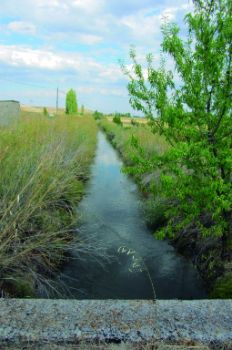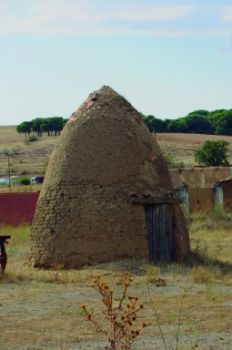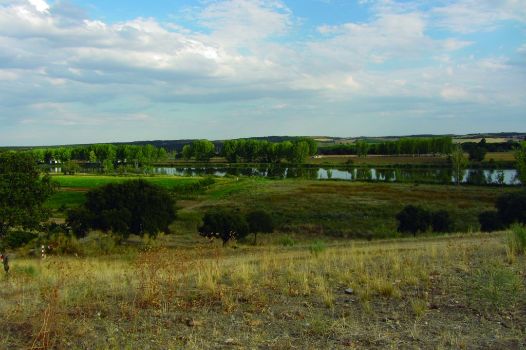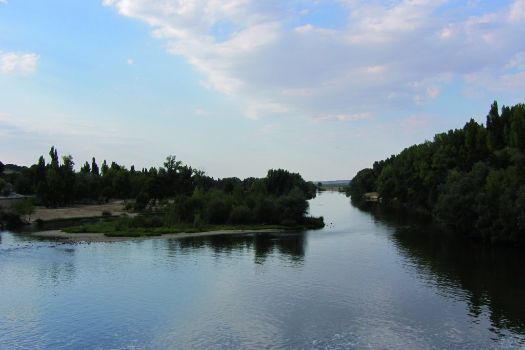Net of Natural
Trails

Stage 16: Tordesillas - Castronuño
Description
Through Vega del Duero - Riberas de Castronuño
This Stage of the Duero Nature Trail traverses through the lands of Zamora. From Tordesillas, the route ventures through farmlands towards "Riberas de Castronuño-Vega del Duero" Nature Reserve, a site of unique beauty, particularly appealing for nature lovers and ornithological tourism.

The first metres of the route are within Tordesillas. The Trail climbs up Avenida de Portugal, then turns left onto Avenida de la Torrecilla de la Abadesa that leads to the bullring. The route leaves Tordesillas along a path that runs next to the Shrine of San Vicente (left), from where one can enjoy stunning views of the surroundings. Shortly after, the route ventures onto Tordesillas Canal's easement road, passing under the A-62 motorway, towards the VP-7701 road. It crosses the road and continues along the canal until it ceases to be passable. Here, the path crosses the road again and runs parallel to it along a farm road that leads to Torrecilla de la Abadesa. The Nature Trail skirts around this town along a road leading to Las Eras, on the edge of the town, with several adobe buildings on the right. It runs parallel again to the canal, crossing the road and venturing into a pinewood that is located within "Riberas de Castronuño-Vega del Duero Nature Reserve”.

The Canal de Tordesillas, which irrigates the crops in the area, escorts the road for a few kilometres until it reaches the paved road to Torre Duero farmstead, where the Ermita de la Virgen, surrounded by vineyards, overlooks the valley. Following the signs, the route traverses through fenced holm oak dehesas to Villa Esperanza farmstead, and then heads towards Caserío de Cubillas, nestled on the cliffs of the Duero.
The holm oak (Quercus ilex) is a species highly resistant to temperature changes, capable of colonising any soil. Many plants grow under the oak, including thyme (Thymus sp.), Spanish lavender (Lavandula stoechas), green lavender cotton (Santolina rosmarinifolia) and small rockrose thickets (Cistus sp.). The road gradually approaches the bank. From here, the landscape opens up and the vegetation is a mix of Mediterranean plants and riparian forest.

Riparian vegetation plays an important role within the Riberas de Castroñuno Nature Reserve. English poplars (Populus nigra) and silver poplars (Populus alba) are the most representative formations. The groves grow near the river, as poplars consume more than two hundred litres of water daily.
Whilst Black-crowned Night Heron (Nycticorax nycticorax) and Grey Herons (Ardea cinerea) breed in poplar groves, Grey Herons (Ardea purpurea) build their nests in the reeds and cattails that line the riverbanks. Ashes (Fraxinus angustifolia), white willows (Salix alba) and elms (Ulmus minor) thrive on the fertile clay soils of Riberas de Castronuño.

As the Stage comes to an end, the Nature Trail crosses a railroad, ventures through La Rinconada oak forest, crosses San José Dam with stunning views of the reservoir and Castronuño, and reaches the CL-602 road where it turns left onto a path wedged between the river and wooden guardrails that climbs up to the town. This stretch is shared with the next Stage.
Sites of interest
Profile

Highlights
Further information
Adobe
Adobe is a construction material previously widely used in territories where rock and stone for masonry were unavailable. It is a mixture of clay and straw, poured into a brick-shaped mould and left to dry in the sun.
Adobe is the construction material typically used in Tierra de Campos because it is versatile and easy to make. Despite its simplicity, there are several steps in making adobe bricks. First, the soil is sifted through a screen to remove debris. It is then piled and mixed with straw, whilst water is slowly added to make mud. Once the mud is ready, it is poured into brick-shaped moulds called "gradillas", "hormas" or "bancales". The mud is pressed tight with the hands and any surplus is removed with a squeegee. Finally, they are allowed to dry evenly in the sun, turning them on edge to reduce cracking.






